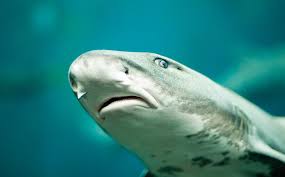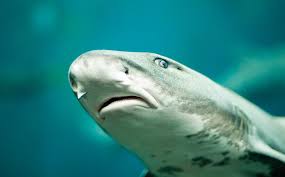
After being separated from her mate, a leopard shark in an Australian aquarium has reproduced asexually.
It is only the third reported case among all vertebrate species and the first reported case of a shark switching from sexual to asexual or parthenogenetic reproduction.
In 2006, the leopard shark, Leonie, was introduced to a male shark at the Reef HQ aquarium in Townsville, Queensland after being captured in the wild in 1999. Leopard sharks are also known as zebra sharks.
Before being separated from her mate in 2012, because the aquarium decided to scale back its breeding program, she began laying eggs in 2008 and had several litters of viable, sexually produced offspring.
Since 2013 sharing a tank with her mother was one of the offspring was Lolly, a female shark. Since she reached sexual maturity, Lolly has not shared a tank with a male shark.
Both Leonie and Lolly laid eggs in 2014.
Laying eggs without a male around was not in itself unusual, says Dr Christine Dudgeon, a biologist with the University of Queensland who has studied the two sharks. This week, she published a report on Leonie’s unusual reproductive shift in Scientific Reports.
“Much like a chicken, they will lay eggs if the conditions are good, whether they are fertile or infertile,” Dudgeon told Guardian Australia.
However, the staff at the aquarium failed to get the eggs hatched after they notices that some of Leonie’s eggs contained embryos and attempted to incubate them.
Eggs that contained embryos were produced by both Leonie and Lolly the next year. Leonie’s hatchling Cleo and Lolly’s hatchling Kitkat are among the five live hatchlings that they together produced and are still on display at the aquarium.
Indicating they were the result of asexual reproduction and not the result of stored sperm, genetic testing of Leonie’s hatchlings revealed elevated homozygosity. Female sharks have been known to store sperm for up to four years.
Leonie’s case was a world first even though asexual reproduction among female sharks that had never reproduced sexually, like Lolly, was not unusual, Dudgeon said.
“The onset of asexual reproduction with the onset of maturity has been documented before with sharks, and rays, and particularly with reptiles, but what we have shown for the first time is the switch,” she said.
She said, it is like “a severe case of inbreeding,” genetically. The offspring are made less hardy as they only have half of her genetic material and are not clones of the mother.
“The idea behind sexual reproduction is you keep mixing up the gene pool to give these animals the biggest set of traits to combat pathogens and other environmental factors that change very rapidly,” she said.
An eagle ray, which reproduced asexually after being separated from her mate for year, and a boa constrictor, which reproduced asexually despite being caged with a male boa constrictor are the only other documented cases of a female switching from sexual to asexual reproduction.
It appeared to be a short-term evolutionary response to extend the reproductive life of a female in response to a scarcity of mates, but it was not clear what triggered the switch,
Dudgeon said.
(Source:www.theguardian.com)
It is only the third reported case among all vertebrate species and the first reported case of a shark switching from sexual to asexual or parthenogenetic reproduction.
In 2006, the leopard shark, Leonie, was introduced to a male shark at the Reef HQ aquarium in Townsville, Queensland after being captured in the wild in 1999. Leopard sharks are also known as zebra sharks.
Before being separated from her mate in 2012, because the aquarium decided to scale back its breeding program, she began laying eggs in 2008 and had several litters of viable, sexually produced offspring.
Since 2013 sharing a tank with her mother was one of the offspring was Lolly, a female shark. Since she reached sexual maturity, Lolly has not shared a tank with a male shark.
Both Leonie and Lolly laid eggs in 2014.
Laying eggs without a male around was not in itself unusual, says Dr Christine Dudgeon, a biologist with the University of Queensland who has studied the two sharks. This week, she published a report on Leonie’s unusual reproductive shift in Scientific Reports.
“Much like a chicken, they will lay eggs if the conditions are good, whether they are fertile or infertile,” Dudgeon told Guardian Australia.
However, the staff at the aquarium failed to get the eggs hatched after they notices that some of Leonie’s eggs contained embryos and attempted to incubate them.
Eggs that contained embryos were produced by both Leonie and Lolly the next year. Leonie’s hatchling Cleo and Lolly’s hatchling Kitkat are among the five live hatchlings that they together produced and are still on display at the aquarium.
Indicating they were the result of asexual reproduction and not the result of stored sperm, genetic testing of Leonie’s hatchlings revealed elevated homozygosity. Female sharks have been known to store sperm for up to four years.
Leonie’s case was a world first even though asexual reproduction among female sharks that had never reproduced sexually, like Lolly, was not unusual, Dudgeon said.
“The onset of asexual reproduction with the onset of maturity has been documented before with sharks, and rays, and particularly with reptiles, but what we have shown for the first time is the switch,” she said.
She said, it is like “a severe case of inbreeding,” genetically. The offspring are made less hardy as they only have half of her genetic material and are not clones of the mother.
“The idea behind sexual reproduction is you keep mixing up the gene pool to give these animals the biggest set of traits to combat pathogens and other environmental factors that change very rapidly,” she said.
An eagle ray, which reproduced asexually after being separated from her mate for year, and a boa constrictor, which reproduced asexually despite being caged with a male boa constrictor are the only other documented cases of a female switching from sexual to asexual reproduction.
It appeared to be a short-term evolutionary response to extend the reproductive life of a female in response to a scarcity of mates, but it was not clear what triggered the switch,
Dudgeon said.
(Source:www.theguardian.com)














